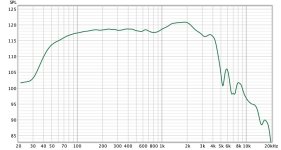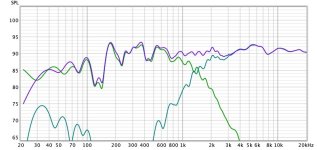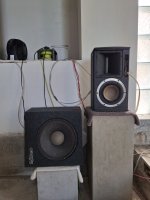impedance curve: the saddle point shows it’s tuned rather deep so this is probably why the bass response droops a bit. This may possibly work well with the room gain
That confirms my suspicion. It definitely goes low! Since I'm using two of the Purifi passive radiators and have not added weight, it would seem that the enclosure volume is too large. Right?
Not necessarily. A speaker with elevated mid-bass often needs less BSC. A speaker with slightly depressed mid-bass but extended deep bass often needs more BSC... your speaker seems like the second type.
You probably need to drop the level of the woofer at 1000 Hz by at least 7 dB, maybe even 9 dB... and of course the tweeter will need to be rebalanced as well.
You probably need to drop the level of the woofer at 1000 Hz by at least 7 dB, maybe even 9 dB... and of course the tweeter will need to be rebalanced as well.
That confirms my suspicion. It definitely goes low! Since I'm using two of the Purifi passive radiators and have not added weight, it would seem that the enclosure volume is too large. Right?
Depends on your performance goals, i.e you basically created an extended bass shelf (EBS) alignment, so de facto it needs significant BSC if there's not enough room/corner gain, so can't comment further until you tell us your performance goals
.
The closed box response is wrong in #2,552. I had the Linkwitz Transform enabled still. Here's the pure (excuse the pun) response with enclosure parameters (note this is quite overdamped - Qtc = 0.45)


I utilized the Thiele-Small parameters for the PTT6.5PR-NF1-01 6.5" Passive Radiator (PR), taken from the Purifi website. The enclosure volume that I used (Vb = 14.0 litres) is a bit larger than "optimal" for a maximally-flat alignment. The shallow shelf before the −3dB cutoff point is a direct result of that larger enclosure volume when used with this particular PR.I assume this alignments is from the box tuning info from our web? we are in the process of updating the tables. The aim is to have the response flat to 0.5dB. I improved the optimization.
Reducing the enclosure volume to 8.2 litres produces a more classical close-to maximally flat low-frequency PR alignment, with a −3dB point of about 49Hz. The model in VituixCAD is shown below, where I have assumed enclosure absorption losses Qa = 100 and leakage losses Ql = 15 (to match those used in post #2,546).
The impedance measurement is interesting. The first impedance peak (at approximately 22Hz) is much lower in amplitude than the second impedance peak (at approximately 50Hz).I don't have a ground plane measurement but this is the impedance of the final speaker with crossover.
The relative heights of the peaks are reversed compared to the VituixCAD simulations shown below. The frequencies of the peaks in the simulation seem to match up very well with the measurement. The height of the second peak in the simulation is very close to the measured value of 43.3 ohms for that peak.
Last edited:
Agreed.It seems to me that I'm losing the normal 6db due to baffle step and another 2-3db from the dual passive radiators.
The difference between a 14 liter and a 15 liter enclosure will be quite minimal. The larger enclosure results in just a fraction of a dB more bass droop. It's hardly noticeable in a simulation.Maybe my 14 liter enclosure is closer to 15 and is too big here.
It does appear to be quite normal.We know that there is a sensitivity sacrifice with these woofers when we take them down low. I was just wondering if this is normal.
When a 14 liter enclosure is used, the ported enclosure produces a very similar response to that of the PR system. Remember that the PR is designed to replace the port. To get back some of that 2dB of sensitivity loss below 100Hz, the ported enclosure would need to be reduced in size to about 8.3 liters and the port tuned to 46Hz. That would produce a low-frequency alignment that is close to being maximally-flat in nature, with an f3 of 50.4Hz, an f6 of 43.6 Hz, and f10 of 37.2Hz.It seems that I'm losing an extra 2dB of sensitivity below 100Hz with the passive radiators compared to a ported enclosure.
The ported systems's response is shown below, and it is quite similar to that of the PR system in an 8.2 liter enclosure that was shown in post #2,566. Of course, the roll-off of the ported enclosure is 24dB/octave (4th order), while that of the PR system is 30dB/octave (5th order).
Last edited:
Well, I would like to have as flat a frequency response as possible with a passive crossover and no additional EQ when measuring it in my listening room. I'm getting a lot of room gain so I think it's actually going to work really well. My nearfierld measurement shows it being pretty flat. The tweeter is a Bliesma T34B so I can take it really low, which allows me to work a bit of baffle step into the 2nd order crossover of the woofer and end up with a mostly flat response. Once I get the crossover in better shape I will try it in the room that was giving me 6-8db gain below 100Hz and I think I will be in good shape.Depends on your performance goals, i.e you basically created an extended bass shelf (EBS) alignment, so de facto it needs significant BSC if there's not enough room/corner gain, so can't comment further until you tell us your performance goals
.
Attachments
I don't have a ground plane measurement...
May I suggest, if you are not able to complete a ground plane measurements, or a mic-in-the-box measurement, as suggested by @lrisbo , consider alternatives to do bass response measurement that doesn't include the effects of your room, but includes/ incorporates both the midwoofer AND passive radiators.
One way to do this, is to place your microphone equidistant from all three sound sources-
As you have your MW on the front panel and PR on the side panels, find the point equidistant between the passive radiators- hopefully they will coincide with the centre point of your midwoofer. Next measure the front the back distance between your woofer and passive radiators. The intersecting line between these should be equidistant between all three. This point is INTERNAL to the cabinet.
Now imagine a point external to the cabinet. This point will be above (or below) your speaker cabinet. The levels will be different depending on whether you choose the top or bottom panel. But you're interested mainly in the shape of the response. So you can choose either, for convenience. Place the tip of the microphone there, about 5-10mm away from the cabinet panel, and perform a measurement at a practical level eg.
(at -20dB FS/1V to avoid overloading your microphone)
This is a close approximation of the 2i anechoic response (before considering baffle diffraction losses) from 10Hz to about 150Hz, before the drivers become directional.
Edits: spelling/grammar for clarity
Last edited:
I think you're dead on here. I'm not going to change the enclosure at this point. The baffle is solid oak and the inside has double walls with mass loaded vinyl in between so it took a lot of work. These Purifi woofers blow my mind with how low they go in such small enclosures and I keep going to large. I re-worked my crossover today and these things sound really good so I'm just going to work with this enclosure. Thanks for doing this math. It confirms my experience.Agreed.
The difference between a 14 liter and a 15 liter enclosure will be quite minimal. The larger enclosure results in just a fraction of a dB more bass droop. It's hardly noticeable in a simulation.
It does appear to be quite normal.
When a 14 liter enclosure is used, the ported enclosure produces a very similar response to that of the PR system. Remember that the PR is designed to replace the port. To get back some of that 2dB of sensitivity loss below 100Hz, the ported enclosure would need to be reduced in size to about 8.3 liters and the port tuned to 46Hz. That would produce a low-frequency alignment that is close to being maximally-flat in nature, with an f3 of 50.4Hz, an f6 of 43.6 Hz, and f10 of 37.2Hz.
The ported systems's response is shown below, and it is quite similar to that of the PR system in an 8.2 liter enclosure that was shown in post #2,566.
View attachment 1331610
When the first peak is lower, it indicates "undertuning", This may translate to a lower potential F10 but higher F3 as the response rolls off sooner. In other words, symmetrical peaks seem to align to a "maximally flat" response.The impedance measurement is interesting. The first impedance peak (at approximately 22Hz) is much lower in amplitude than the second impedance peak (at approximately 50Hz).
The relative heights of the peaks are reversed compared to the VituixCAD simulations shown below. The frequencies of the peaks in the simulation seem to match up very well with the measurement. The height of the second peak in the simulation is very close to the measured value of 43.3 ohms for that peak.
View attachment 1331594
I will give this a shot tomorrow. Thanks!May I suggest, if you are not able to complete a ground plane measurements, or a mic-in-the-box measurement, as suggested by @lrisbo , consider alternatives to do bass response measurement that doesn't include the effects of your room, but includes incorporates the midwoofer AND passive radiators.
One way to do this, is to place your microphone equidistant from all three sound surfaces.
As you have your MW on the front panel and PR on the side panels, find the point eqidistant between the passive radiators- hopefully they will coincide with the centre point of your midwoofer. Next measure the front the back distance between your woofer and passive radiators. The intersecting line between these should be equidistant between all three. This point is INTERNAL to the cabinet.
Now you imagine a point external to the cabinet This point will be above your speaker cabinet, or below. lace the microphone point there. Place your mic there, above 5-10mm from the cabinet panel, and perform a measurement (at -20dB FS to avoid overloading your microphone eg. <1V)
This is a close approximation of the anechoic response (2i) from 10Hz to about 150Hz, before the drivers become directional.
That's a good goal to have in a high-fidelity loudspeaker.Well, I would like to have as flat a frequency response as possible with a passive crossover and no additional EQ when measuring it in my listening room.
How close to the nearest wall will your speakers be situated?I'm getting a lot of room gain so I think it's actually going to work really well.
Your crossover frequency for the Bliesma T34B seems to be set at about 1.5kHz, and the filtered response is –6dB at that point. That's probably about as low in frequency as is prudent. Bliesma's power handling measurements are taken with a 2nd-order 12dB/octave high pass filter set to 2.5kHz. The T34B-4 has a quite high sensitivity of 97.5 dB at 2.83V/1m, so it is likely to have needed a bit of attenuation to blend in with the woofer. That will help protect it from excessive power input when used with a lower crossover frequency.My nearfield measurement shows it being pretty flat. The tweeter is a Bliesma T34B so I can take it really low, which allows me to work a bit of baffle step into the 2nd order crossover of the woofer and end up with a mostly flat response.
Last edited:
I only use the Purify as part of my Alcons ribbon PA system, it runs from 450Hz to 1200Hz.Yes, I was just about to offer the opinion that @ZestClub 's project did not have enough (or did not have any) baffle step compensation...
Used to cross the ribbon it works seamlessly - impossible to tell where one begins and the other ends.
Attachments
That's a good goal to have in a high-fidelity loudspeaker.Well, I would like to have as flat a frequency response as possible with a passive crossover and no additional EQ when measuring it in my listening room.
---
Actually not a good goal. Listening tests tell that we humans prefer non-flat spl response at listening spot. Flat in nearfield 0,5-1m would be ok.
Quoting from a JAES paper by Toole: "Listeners, it seems, like the sound of loudspeakers with a flat, smooth wide band on-axis amplitude response that is maintained at substantial angles off axis." [emphasis added]
Note also, in Fig. 14, the line corresponding to the predicted steady-state room curve has the added information "Flat direct sound".
It's interesting to note that so-called "untrained listeners" subjectively prefer an in-room sound quality that boosted bass and boosted high frequencies.
Note also, in Fig. 14, the line corresponding to the predicted steady-state room curve has the added information "Flat direct sound".
It's interesting to note that so-called "untrained listeners" subjectively prefer an in-room sound quality that boosted bass and boosted high frequencies.
Last edited:
Please notice that the Olive/Harman curves are normalized to 500Hz. Preferred "trained listeners" curve has also downslope towards high requencies.
We amateur diyers must design low freq per simulations, nearfield and room response. Sometimes outdoor open space or groundplane measurements are possible. This is problem is not painful with actives or if the end user will use room eq of the signal anyway.
Flat anechoic on-axis at 2m is a good target with speakers with typical non-waveguide 3-way construction, low and smooth DI.
Klippel NFS from bikinpunk (Erin's Audio Corner)


And a 6,5" 2-way

This speaker doesn't use waveguide for the tweeter

We amateur diyers must design low freq per simulations, nearfield and room response. Sometimes outdoor open space or groundplane measurements are possible. This is problem is not painful with actives or if the end user will use room eq of the signal anyway.
Flat anechoic on-axis at 2m is a good target with speakers with typical non-waveguide 3-way construction, low and smooth DI.
Klippel NFS from bikinpunk (Erin's Audio Corner)
And a 6,5" 2-way
This speaker doesn't use waveguide for the tweeter
Last edited:
Have some good news today. Finally have two 10-inch Purifis with four matching passive radiators coming. This means I have to lock down the bass cabinet design. Present cabinet design is only a bit wider than the drivers, but is fairly deep, with the passives on the side.
My plan is a full Purifi build with 6.5-inch M's and the coming tweeter in a smaller but also relatively narrow cabinet sitting on top of the bass cabinet.
A neighbour is trying to convince me to package protect for mounting open baffles above the bass cabinet… with a wider and less deep bass cabinet below, on which the open baffle can sit. Like Wolf Van Langas.
Any feedback from anyone here based on your experience? Should I stick with what people I know personally have already done… relatively narrow but deeper cabinet with passives on the side for the Purifis… or what about a wider but not so deep solution???
My plan is a full Purifi build with 6.5-inch M's and the coming tweeter in a smaller but also relatively narrow cabinet sitting on top of the bass cabinet.
A neighbour is trying to convince me to package protect for mounting open baffles above the bass cabinet… with a wider and less deep bass cabinet below, on which the open baffle can sit. Like Wolf Van Langas.
Any feedback from anyone here based on your experience? Should I stick with what people I know personally have already done… relatively narrow but deeper cabinet with passives on the side for the Purifis… or what about a wider but not so deep solution???
- Home
- Loudspeakers
- Multi-Way
- Exploring Purifi Woofer Speaker Builds


